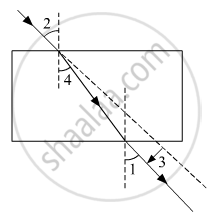Advertisements
Advertisements
प्रश्न
Explain why the planets do not twinkle but the stars twinkle.
उत्तर
The planets being closer to the Earth do not appear as point sources of light. The planet covers a small circular area in space, when viewed from Earth. So, even if light from one point in the circular disc is blocked, light from other points reaches our eyes. As the light from the planets are not completely blocked from our sight and they do not twinkle. Stars on the other hand are point sized objects and twinkle by atmospheric refraction of light.
APPEARS IN
संबंधित प्रश्न
Explain why the planets do not twinkle.
The correct sequencing of angle of incidence, angle of emergence, angle of refraction and lateral displacement shown in the following diagram by digits 1, 2, 3 and 4 is:

(a) 2, 4, 1, 3
(b) 2, 1, 4, 3
(c) 1, 2, 4, 3
(d) 2, 1, 3, 4
The atmospheric refraction of light causes the twinkling of:
(a) planets only
(b) stars only
(c) planets and stars
(d) stars and satellites
As light from a far off star comes down towards the earth:
(a) it bends away from the normal
(b) it bends towards the normal
(c) it does not bend at all
(d) it is reflected back
The day is longer on the earth by about 4 minutes because:
(a) the earth is round in shape
(b) the earth rotates on its axis
(c) the earth revolves around the sun
(d) the earth has atmosphere
We know that light refracts (or bends) when it goes from one medium to another. Now, the atmosphere contains only air. Then how does light get refracted on passing through only air in the atmosphere?
A student claims that because of atmospheric refraction, the sun can be seen after it has set, and the day is, therefore, longer than if the earth had no atmosphere.
Do you think that the students conclusion is correct?
Why does the sky appear blue on a clear day?
Refraction of light by the earth’s atmosphere due to variation in air density is called ____________.
How does refraction take place in the atmosphere? Why do stars twinkle but not the planets?
